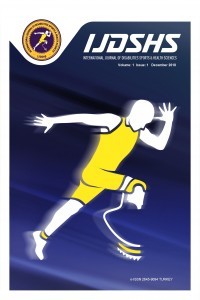Is Nationality A Factor Affecting Serve Type, Serve Speed and Success In Professional Volleyball League?
Is Nationality A Factor Affecting Serve Type, Serve Speed and Success In Professional Volleyball League?
Volleyball, Match analysis, Serve analysis,
___
- A. Katsikadelli. (1996). A comparative study of the attack serve in high-level volleyball tournaments. Journal of Human Movement Studies, 30(6), 259–268. Retrieved from https://www.researchgate.net/publication/293527861_A_comparative_study_of_the_attack_serve_in_high-level_volleyball_tournaments
- Afonso, J., Esteves, F., Araújo, R., Thomas, L., & Mesquita, I. (2012). Tactical determinants of setting zone in elite men’s volleyball. Journal of Sports Science and Medicine, 11(1), 64–70.
- Berghorn, F. J., Yetman, N. R., & Hanna, W. E. (1988). Racial Participation and Integration in Men’s and Women’s Intercollegiate Basketball: Continuity and Change, 1958–1985. Sociology of Sport Journal, 5(2), 107–124. http://doi.org/10.1123/ssj.5.2.107
- Ciuffarella, A., Russo, L., Masedu, F., Valenti, M., Izzo, R. E., & De Angelis, M. (2013). Notational Analysis of the Volleyball Serve. Timisoara Physical Education and Rehabilitation Journal, 6(11), 29–35. http://doi.org/10.2478/tperj-2013-0013
- Curtis James E.; Loy, J. W. (1978). Race/Ethnicity and Relative Centrality of Playing Positions in Team Sports: Exercise and Sport Sciences Reviews. Exercise and Sport Sciences Reviews, 6(1), 285. Retrieved from https://journals.lww.com/acsm-essr/Citation/1978/00060/RACE_ETHNICITY_AND_RELATIVE_CENTRALITY_OF_PLAYING.8.aspx
- Eitzen, D. S., & Furst, D. (1989). Racial Bias in Women’s Collegiate Volleyball. Journal of Sport and Social Issues, 13(1), 46–51. http://doi.org/10.1177/019372358901300104
- Fernandez-Echeverria, C., Gil, A., Moreno, A., Claver, F., & Moreno, M. P. (2015). Analysis of the variables that predict serve efficacy in young volleyball players. International Journal of Performance Analysis in Sport, 15(1), 172–186. Retrieved from https://www.tandfonline.com/doi/pdf/10.1080/24748668.2015.11868785?needAccess=true
- Forthomme, B., Croisier, J.-L., Ciccarone, G., Crielaard, J.-M., & Cloes, M. (2005). Factors Correlated with Volleyball Spike Velocity. The American Journal of Sports Medicine, 33(10), 1513–1519. http://doi.org/10.1177/0363546505274935
- García-de-Alcaraz, A., Ortega, E., & Palao, J. M. (2016). Effect of Age Group on Technical–Tactical Performance Profile of the Serve in Men’s Volleyball. Perceptual and Motor Skills, 123(2), 508–525. http://doi.org/10.1177/0031512516660733
- Jiménez-Olmedo, J. M., Penichet-Tomás, A., Sáiz-Colomina, S., Martínez-Carbonell, J. A., & Jove-Tossi, M. A. (2012). Serve analysis of professional players in beach volleyball. Journal of Human Sport and Exercise, 7(3), 706–713. http://doi.org/10.4100/jhse.2012.73.10
- Kolman, N., Huijgen, B., Kramer, T., Elferink-Gemser, M., & Visscher, C. (2017). The Dutch Technical-Tactical Tennis Test (D4T) for Talent Identification and Development: Psychometric Characteristics. Journal of Human Kinetics, 55, 127–138. http://doi.org/10.1515/hukin-2017-0012
- Macquet, A. C. (2009). Recognition Within the Decision-Making Process: A Case Study of Expert Volleyball Players. Journal of Applied Sport Psychology, 21(1), 64–79. http://doi.org/10.1080/10413200802575759
- Melrose, D. R., Spaniol, F. J., Bohling, M. E., & Bonnette, R. A. (2007). Physiological and Performance Characteristics of Adolescent Club Volleyball Players. The Journal of Strength and Conditioning Research, 21(2), 481. http://doi.org/10.1519/R-19185.1
- Moras, G., Buscà, B., Peña, J., Rodríguez, S., Vallejo, L., Tous-Fajardo, J., & Mujika, I. (2008). A comparative study between serve mode and speed and its effectiveness in a high-level volleyball tournament. Journal of Sports Medicine and Physical Fitness, 48(1), 31–36. http://doi.org/10.1002/14651858.CD005954.pub2.Fundings.
- Palao, J. M., & Valades, D. (2009). Testing protocol for monitoring spike and serve speed in volleyball. Strength and Conditioning Journal, 31(6), 47–51. http://doi.org/10.1519/SSC.0b013e3181c21b3f
- Papadimitriou, K., Pashali, E., Sermaki, I., Mellas, S., & Papas, M. (2004). The effect of the opponents’ serve on the offensive actions of Greek setters in volleyball games. International Journal of Performance Analysis in Sport, 4(1), 23–33. http://doi.org/10.1080/24748668.2004.11868288
- Peña, J., Rodríguez-Guerra, J., Buscà, B., & Serra, N. (2013). Which Skills and Factors Better Predict Winning and Losing in High-Level Menʼs Volleyball? Journal of Strength and Conditioning Research, 27(9), 2487–2493. http://doi.org/10.1519/JSC.0b013e31827f4dbe
- Quiroga, M. E., García-Manso, J. M., Rodríguez-Ruiz, D., Sarmiento, S., De Saa, Y., & Moreno, M. P. (2010). Relation between In-Game Role and Service Characteristics in Elite Womenʼs Volleyball. Journal of Strength and Conditioning Research, 24(9), 2316–2321. http://doi.org/10.1519/JSC.0b013e3181e3812e
- Quiroga, M. E., Rodriguez-Ruiz, D., Sarmiento, S., Muchaga, L. F., Da Silva Grigoletto, M., & García-Manso, J. M. (2012). Characterisation of the Main Playing Variables Affecting the Service in High-Level Women’s Volleyball. Journal of Quantitative Analysis in Sports, 8(1), 1–13. http://doi.org/10.1515/1559-0410.1348
- Smith, D. J., Roberts, D., & Watson, B. (1992). Physical, physiological and performance differences between canadian national team and universiade volleyball players. Journal of Sports Sciences, 10(2), 131–138. http://doi.org/10.1080/02640419208729915
- Tocci, N. X., Howell, D. R., Sugimoto, D., Dawkins, C., Whited, A., & Bae, D. (2017). The Effect of Stride Length and Lateral Pelvic Tilt on Elbow Torque in Youth Baseball Pitchers. Journal of Applied Biomechanics, 33(5), 339–346. http://doi.org/10.1123/ijspp.2015-0012
- Yayın Aralığı: Yılda 3 Sayı
- Başlangıç: 2018
- Yayıncı: Nevzat DEMİRCİ
Nihan ÖZÜNLÜ PEKYAVAŞ, Senay CEREZCİ DUYGU, Özge ÇINAR-MEDENİ, Emre ALTUNDAG, Cengiz AKARÇEŞME, Filiz Fatma ÇOLAKOĞLU, Gül BALTACI
Muhammed Yunusnur NİŞLİ, Ahmet ŞİRİNKAN, Zaim Alparslan ACAR, Emine ÖZ NİŞLİ, Hatice TOY
Comparison of Upper Extremity Physical Fitness Levels in Wheelchair Archery and Basketball Athletes
Ayşe Büşra ERTEN, Gülay ARAS BAYRAM, Candan ALGUN
Burnout Levels of Teachers Working In Special Education
Fatih ÖZDEN, Ahmet ARIK, Mehmet ÖZKESKİN, Serkan BAKIRHAN
Leisure and Recreation Activities for Disabled People
Ülfet ERBAŞ, Hüseyin GÜMÜŞ, Laurentiu-gabriel TALAGHİR
The Effect of Exercise Training for Refugee Wheelchair Users
